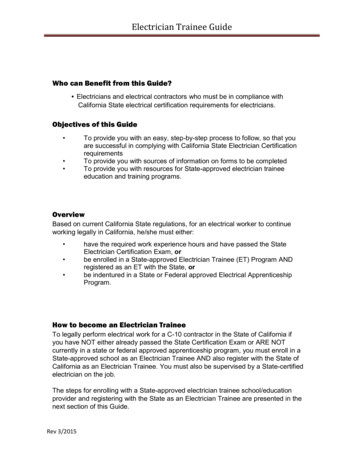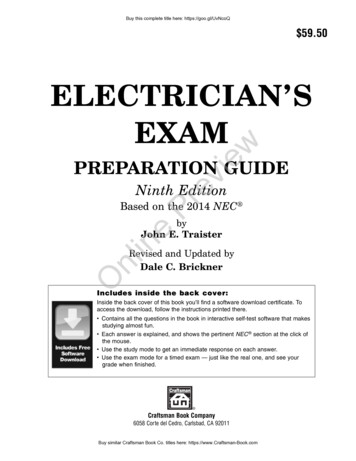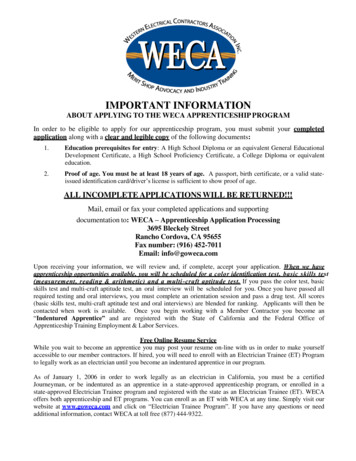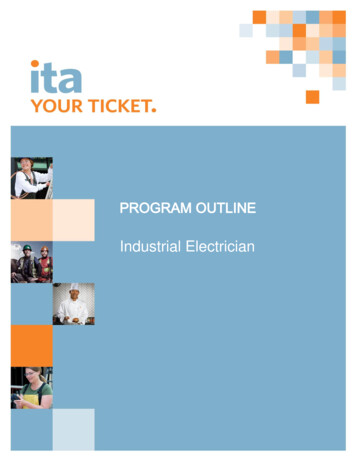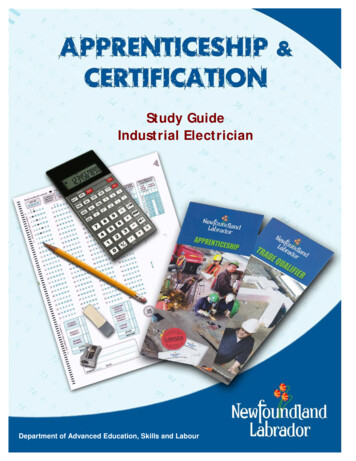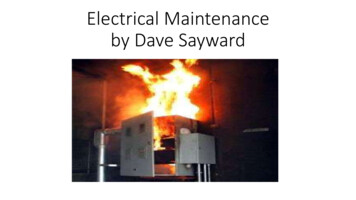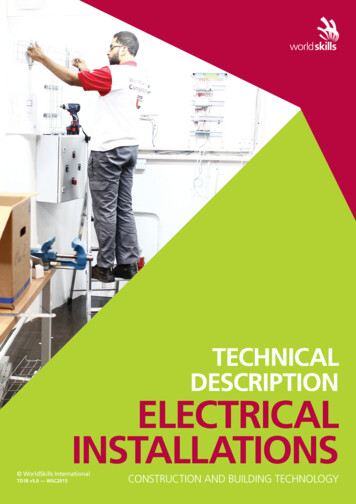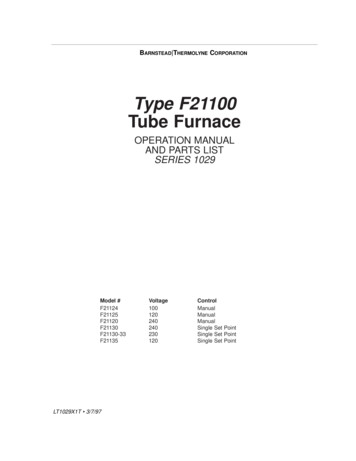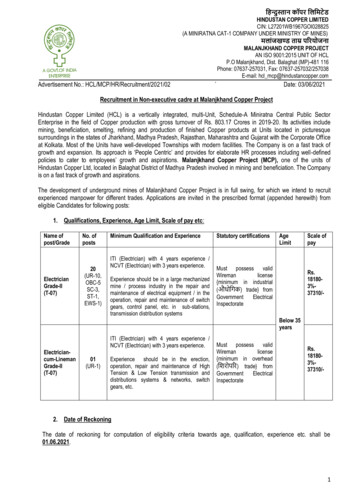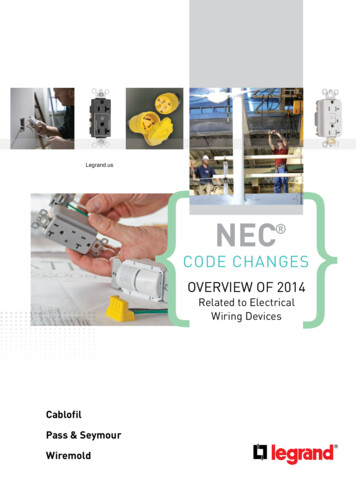
Transcription
COMPETENCY BASED CURRICULUMFOR THE TRADE OFELECTRICIANUNDERCRAFTSMAN TRAINING SCHEME (CTS)IN SEMESTER PATTERNBYGOVERNMENT OF INDIAMINISTRY OF SKILL DEVELOPMENT & ENTREPRENEURSHIPDIRECTORATE GENERAL OF TRAINING1
16.TopicsIntroductionJob roles: reference NOS & NCONSQF compliance blockLearning outcomeGeneral informationCourse structureGeneral Training Plan, Examination & Pass RegulationAssessable outcomeAssessment criteriaSyllabus content with time structure10.1 Syllabus content for Professional Skill & Knowledge10.2 Syllabus content of core skillsEmployability skills11.1 General information11.2 Distribution of topics between semesters for employability skill11.3 Syllabus content of Employability SkillInfrastructureAssessment standard13.1Assessment guideline13.2 Internal assessments (Formative assessment)13.3 Final assessment- All India Trade Test(Summative assessment)List of trade committee membersList of Tools & Equipment-Annexure-IGuidelines for instructors and paper setters- Annexure-II2Page No.3-45-678-91011121314-2223–3738 - 46474849- 535455-5960-6162-6768
1. INTRODUCTIONIndia is one of the youngest nations in the world. Our youth are our strength. However, achallenge facing the country is that of skilling our youth as per the demands of the industry.Recognizing the need for quickly coordinating the skill development and entrepreneurshipefforts of all concerned stakeholders, the Government of India created the Ministry of SkillDevelopment and Entrepreneurship on 9th November, 2014. To create further convergencebetween the Vocational Training System through Industrial Training Institutes (ITIs) and thenew skill initiatives of the Government, the Training and Apprenticeship Training divisionsfrom the Directorate General of Employment and Training (DGET) under the Ministry ofLabour and Employment stand transferred to the Ministry of Skill Development andEntrepreneurship (MSDE) with effect from 16th April, 2015. This move brings over 11000ITIs and scores of other institutions, and the Apprenticeship and Training divisions, underthe Ministry.The Ministry of Skill Development and Entrepreneurship is an apex organization for thedevelopment and coordination of the vocational training including Women’s VocationalTraining in our country. The Ministry conducts the vocational training programmes throughthe Craftsmen Training Scheme (CTS), Apprenticeship Training Scheme (ATS), ModularEmployable Scheme (MES) under the Skill Development Initiative (SDI) Scheme, andCraftsmen Instructor Training Scheme (CITS) to cater the needs of different segments of theLabour market. The National Council for Vocational Training (NCVT) acts as a centralagency to advise Government of India in framing the training policy and coordinatingvocational training throughout India. The day-to-day administration of the ITIs rests withthe State Governments/ Union Territories. Training courses under the CTS is being offered through a network of more than 11000Government and Private Industrial Training Institutes (ITIs) located all over the countrywith a total seating capacity of more than 16 Lakhs with an objective to provide skilledworkforce to the industry in 126 trades. Skill development courses exclusively for womenare also being offered under CTS and other schemes through Government and PrivateITIs and Regional Vocational Training Institutes (RVTIs) for Women. The Apprentices Act, 1961 was enacted with the objective of regulating the program ofapprenticeship training in the industry by utilizing the facilities available within forimparting on-the-job training. The Act makes it obligatory for employers in specifiedindustries to engage apprentices in designated trades to impart on the job training forschool leavers, and ITI passed outs to develop skilled manpower for the industry. The Ministry is implementing the Employable Scheme (MES) under the SkillDevelopment Initiative Scheme to provide vocational training to people to developskilled manpower for the industry through a network of Vocational Training Providers(VTPs) located across the country.Central Staff Training and Research Institute (CSTARI), Kolkata is the nodal institute forthe development/revision of curricula under all vocational training schemes of the Ministry.3
National Instructional Media Institute (NIMI), Chennai is to make available instructionalmaterial in various trades for the use of trainees and trainers to ensure overall improvementin the standard of institutional training under the CTS and ATS schemes. The institute isactively involved in the development, production and dissemination of instructional mediaPackages (IMPs) comprising of books on Trade Theory, Trade Practical, Test/Assignment,and Instructor’s Guide.The National Skills Qualification Framework (NSQF), published in the Gazette of Indiaon 27th December, 2013, is a national framework that aims to integrate general andvocational streams of education and training. The main goal of the NSQF is to focus oncompetency-based qualifications, which in turn facilitate and enhance transparency, bothwithin and between general and vocational streams. The National Skill Development Agency(NSDA) under the Ministry is responsible for anchoring and implementation of theFramework, by bringing together the key stakeholders through the National SkillQualifications Committee (NSQC).The competency-based framework organizes qualifications into ten levels, with the entrylevel being 1, and the highest level being 10. Each level of the NSQF is described by astatement of learning outcomes in five domains, known as level descriptors. These fivedomains are (1) Process, (2) Professional knowledge, (3) Professional skill, (4) core skill, and(5) Responsibility. The paradigm shift from learning focused on inputs to anoutcome/competency-based education would help in the Recognition of Prior Learning(RPL), and simultaneously enable the alignment of the Indian qualifications withinternational ones. Government funding is expected to be on a preferential basis for NSQFcompliant courses. The NSQF notification provides a Qualification Register, which is theofficial national database of all qualifications aligned to NSQF levels. Through this Register,learners can expect access to all NSQF compliant qualifications.The Ministry has set up Mentor Councils to focus on courses under NCVT in varioussectors with representation from thought leaders among different stakeholders viz.,industries, innovative entrepreneurs who have proved to be game-changers,academic/professional institutions, and champion ITIs for each of the sectors. The MentorCouncil for each sector reviews curriculum, admission criteria, course duration, andrequirement of trainers and assessment/evaluation systems for the sector on a continuousbasis and make recommendations regarding the same. Sector-wise Core Groups are formedto plan and prepare the documentation for the competency-based curricula for the coursesunder each sector.4
1.JOB ROLES: Reference NOS & NCOBrief description of Job roles:Electrician, General installs, maintains and repairs electrical machinery equipment andfittings in factories, workshops power house, business and residential premises etc., Studiesdrawings and other specifications to determine electrical circuit, installation details, etc. Positionsand installs electrical motors, transformers, switchgears. Switchboards, Microphones, loudspeakers and other electrical equipment, fittings and lighting fixtures. Makes connections andsolders terminals. Test electrical installations and equipment and locates faults using megger, testlamps etc. Repairs or replaces defective wiring, burnt out fuses and defective parts and keepsfittings and fixtures in working order. May do armature winding, draw wires and cables and dosimple cable jointing. May operate, attend and maintain electrical motors, pumps etc.Electrical Electricianfits and assembles electrical machinery and equipment such asmotors, transformers, generators, switchgears, fans etc., Studies drawings and wiring diagrams offittings, wiring and assemblies to be made. Collects prefabricated electrical and mechanicalcomponents according to drawing and wiring diagrams and Check them with gauges, meggeretc,to ensure proper function and accuracy. Fits mechanical components, resistance, insulators, etc., asper specifications, doing supplementary tooling where necessary. Follows wiring diagrams, makeselectrical connections and solders points as specified. Check for continuity, resistance, circuitshorting, leakage, earthing, etc, at each stage of assembly using megger, ammeter, voltmeter andother appliances and ensures stipulated performance of both mechanical and electricalcomponents filled in assembly. Erects various equipment’s such as bus bars, panel boards,electrical posts, fuse boxes switch gears, meters, relays etc, using non-conductors, insulationhoisting equipment as necessary for receipt and distribution of electrical current to feeder lines.Installs motors, generators, transformer etc., as per drawings using lifting and hoisting equipmentas necessary, does prescribed electrical wiring, and connects to supply line. Locates faults in caseof breakdown and replaces blown out fuse, burnt coils, switches, conductors etc, as required.Check, dismantles, repairs and overhauls electrical units periodically or as required according toscheduled procedure. May test coils. May specialize in repairs of particular equipmentmanufacturing, installation or power house work and be designated accordingly.5
Reference NCO & 851.30)6
3. NSQF COMPLIANCE BLOCKNSQF level for Electrician trade under CTS: Level 4As per notification issued by Govt. of India dated- 27.12.2013 on National SkillQualification Framework total 10 (Ten) Levels are defined.Each level of the NSQF is associated with a set of descriptors made up of fiveoutcome statements, which describe in general terms, the minimumknowledge, skills and attributes that a learner needs to acquire in order to becertified for that level.Each level of the NSQF is described by a statement of learning outcomes infive domains, known as level descriptors. These five domains are:a.Processb.professional knowledge,c.professional skill,d.core skill ande.Responsibility.The Broad Learning outcome of Electrician trade under CTS mostly matcheswith the Level descriptor at Level- 4.The NSQF level-4 descriptor is given below:LEVELLevel4Processrequiredwork infamiliar,predictable,routine,situationof clear choiceProfessionalknowledgefactualknowledgeof field ofknowledgeor studyProfessional skillrecall anddemonstratepracticalskill, routineandrepetitive innarrowrange ofapplication,usingappropriaterule andtool, usingqualityconcepts7Core skilllanguage tocommunicatewritten or oral,with requiredclarity, skill tobasic Arithmeticand algebraicprinciples, basicunderstanding ofsocial politicaland naturalenvironmentResponsibilityResponsibility forown workandlearning.
4. Learning outcomeThe following are minimum broad general learning outcome after completionof the Electrician course of 02 years duration:A. GENERIC OUTCOME1. Recognize & comply safe working practices, environment regulation and housekeeping.2. Work in a team, understand and practice soft skills, technical English to communicatewithrequired clarity.3. Demonstrate knowledge of concept and principles of basic arithmetic, algebraic,trigonometric, and statistics and apply knowledge of specific area to perform practicaloperations.4. Understand and explain basic science in the field of study including friction, simplemachine and heat and temperature.5. Read and apply engineering drawing for different application in the field of work.6. Understand and explain the concept in productivity, quality tools and labour welfarelegislation and apply such in day to day work to improve productivity & quality.7. Explain energy conservation, global warming and pollution and contribute in day to day workby optimally using available resources.8. Explain personnel finance, entrepreneurship and manage/organize related task in day to daywork for personal & societal growth.9. Understand and apply basic computer working, basic operating system and uses internetservices to get accustomed & take benefit of IT developments in the industry.B. SPCIFIC OUTCOME10. Make good quality suitable for applications electrical wire joints for single and multistrandconductors, soldering and taking suitable care and safety.11. Draw and set up DC and AC circuits including R-L-C circuits with accurate measurement ofvoltage, current, resistance, power, power factor and energy using ammeter, voltmeter, ohmmeter, watt-meter, energy meter, power factor meter and phase sequence tester with propercare and safety.12. Make choices to carry out basic jobs of marking out the components for filing, drilling, andriveting, fitting and assembled using different components independently.13. Identify the type of batteries, construction, working and application of Ni-cadmium, lithiumcell, lead acid cell etc. Demonstrate their charging and discharging, choosing appropriatemethod and carryout the installation and routine maintenance with due care and safety.14. a) Assemble, test, analyze and repair power supply using the following circuits:Half–wave, full-wave, and bridge rectifiers with filter & without filter.Switching circuit using the following:- UJT, JFET, IGBT, SCR, DIAC, TRIAC8
b) Measurement of voltage, frequency, time period using CRO.c) Trouble shoot and maintenance of voltage stabilizer, inverter and UPS15. Draw, estimate, wire up, test different type of domestic and industrial wiring circuits as perIndian Electricity rules and taking care of quality. Construction and working of MCB &ELCB. Test a domestic/industrial wiring installation using Megger.16. Plan and install Pipe & Plate earthing. Measure earthing resistance by earth tester.17. Understand the constructional features, working principles of DC machine.Starting withsuitable starter, running, forward and reverse operation and speed control of DC motors.Conduct the load performance test of DC machine with due care and safety. Maintain andtroubleshoot of DC machines.18. Understand the types, constructional features, working principles of transformer ( single &three phase). Maintenance and application of Transformer.19. Understand the constructional features, working principles of single phase and 3 phase ACmotors.Starting with suitable starter, running, forward and reverse operation and speedcontrol of AC motors. Conduct the load performance test of AC machine with due care andsafety. Maintain and troubleshoot of AC motors.20. Understand the constructional features, working principles of Alternator and MotorGenerator set.Install, set-up and test synchronization of Alternator and Motor-Generator setwith due care and safety.Maintain and troubleshoot of the machines.21. Test and perform Winding for small transformer, armature, field winding and machines.22. Plan and execute electrical illumination system viz. FL tube, HPMV lamp, HPSV lamp, etc.23. Select, assemble, test and wire-up control panel for three phase AC Motors.24. Identify parts, installation, service, troubleshoot and repair of electrical appliances viz.Electric iron, heater, kettle, automatic toaster, geyser, mixer & grinder, washing machine andfan with due care and safety.25. Prepare single line diagram and layout plan of electrical transmission & distribution systemsand plants with knowledge of principles and processes. Make and test cable joints ofunderground cable, identify parts and troubleshoot circuit breakers with care and safety.NOTE: Learning outcomes are reflection of total competencies of a trainee. Each learningoutcome may include multiple assessment components. However assessment will be carriedout as per assessable outcome and assessment criteria.9
5. GENERAL INFORMATION1. Qualification: ELECTRICIAN2. Ref. N.C.O. /NOS Code No.: 7137.10(851.10), 7241.20(851.30)3. NSQC Level: Level - IV4. Duration of Craftsmen Training: 2 Years (4 Semesters each of six months duration)5. Entry Qualification: Passed 10th class with Science and Mathematics under10 2 system of Education or its equivalent.6. Trainees per unit: 16 ( Max. supernumeraries seats : 5)Distribution of training on Hourly basis:Total hours/weekTradepracticalTradetheory40 Hours25 Hours6 HoursWorkshop Cal.& Sc.2 laractivity3 Hours2 Hours2 Hours
6. COURSE STRUCTURE1. Name of the Qualification :- ELECTRICIAN2. Total duration of the course: - 24 Months3. Training duration details : COURSE ELEMENTSHOURLY DISTRIBUTIONAPROFESSIONAL SKILL2200 HRSBCDEFGHPROFESSIONAL KNOWLEDGEWORKSHOP CALCULATION & SCIENCEENGINEERING DRAWINGEMPLOYABILITY SKILLSEXTRA CURRICULAR ACTIVITIES/LIB.INPLANT TRG./PROJECT WORKADMISSION & EXAMINATION530 HRS180 HRS265 HRS110 HRS180 HRS240 HRS160 HRSPIE-CHARTHourly distributionProf. SkillProf. KnowledgeWorkshopCalculation &ScienceEngineeringDrawingExtra Curr.ActivitiesAdmission &ExaminationInplantTrg./Project work11
8.General Training Plan, Examination & Pass regulationGeneral Training PlanThe skills stated in Learning outcome are to be imparted in accordancewith the instructions contained within Section 10 in respect of the content andtime structure of the vocational education and training (General TrainingPlan).ExaminationEach Semester examination is to take place after the end of the sixmonths of training. The each semester examination encompasses such skills asare listed for that period of training (Detail in Section -10) and also includestheoretical knowledge, Core skills & E/S. The E/S will be covered in first twosemesters only.Candidates are to demonstrate that they are able to:1. Read& interpret technical parameters/documentation, plan and organizework processes, identify necessary materials and tools;2. Perform task with due consideration to safety rules, accident preventionregulations and environmental protection stipulations;3. Apply professional knowledge, core skills & employability skills whileperforming the task.4. Check the job as per drawing/assembly for functioning, identify and rectifyerrors in job/assembly.5. Document the technical parameters related to the task undertaken.The details of the examination and assessment standard are as per section - 11Pass regulationFor the purposes of determining the overall result, weighting of 25percent is applied to each semester examination. The minimum pass percentfor Practical is 60% & minimum pass percent for Theory subjects 40%.12
9. ASSESSABLE OUTCOMESAssessable outcomes after completion of two years Electrician courseI.Generic:1.2.3.4.Apply safe working practices.Comply environment regulation and housekeepingInterpret & use Company terminology and technical communicationDemonstrate knowledge of concept and principles of basic arithmetic, algebraic,trigonometric, and statistics and apply knowledge of specific area to perform practicaloperations.5. Understand and explain basic science in the field of study including friction, simple machineand heat and temperature.6. Read and apply engineering drawing for different application in the field of work.7. Understand and explain the concept in productivity, quality tools, and labour welfarelegislation and apply such in day to day work to improve productivity & quality.8. Explain energy conservation, global warming and pollution and contribute in day to daywork by optimally using available resources.9. Explain personnel finance, entrepreneurship and manage/organize related task in day to daywork for personal & societal growth.10. Understand and apply basic computer working, basic operating system and uses internetservices to get accustomed & take benefit of IT developments in the industry.II.Specific:11. Make electrical wire joints & soldering.12. Analyze, demonstrate and test basic electrical connection.13. Prepare profile with an appropriate accuracy as per drawing.14. Test, service, recharge & installation of batteries.15. Plan and prepare Earthing installation.16. Analyze, Assemble, check and repair electronic control circuit.17. Assemble, installand test wiring system.18. Installtest and setup DC machines.19. Install, test and commission of transformer.20. Select and perform electrical/ electronic measurement.21. Install, test and set up AC motors.22. Install, test and setup alternator & MG set.23. Analyze, test and perform winding.24. Plan and execute electrical illumination system.25. Assemble and wire switch cabinets for 3 phase AC motors.26. Maintain, repair & test of domestic Appliances.27. Analyze the power plant layout and power lines.13
9. ASSESSABLE OUTCOME WITH ASSESSMENT CRITERIAASSESSABLE OUTCOME ALONGWITH ASSESSMENT CRITERIATOACHIEVED AFTER EACH SEMESTER & COMPLETION OF QUALIFICATIONBEi) The training shall be conducted as per syllabus defined in reference no: Section 10.ii) The trainee shall demonstrate the competencies which are defined below in assessableoutcome and assessment criteria.iii) All the assessable outcomes are to be tested during formative assessment, Theory & Practicalexaminations, various observation and viva-voce.iv) Assessable outcome of Employability Skills, Workshop Calculation & Science andEngineering Drawing shall be tested separately and also be applied in Theory and Practicalexaminations.v) These assessable outcomes and assessment criteria will serve as guide lines for Trainers,Paper setters, Moderators and Assessors.GENERIC ASSESSABLE OUTCOME:ASSESSABLEOUTCOMES1.Apply safe workingpracticesASSESSMENT CRITERIA1.1 Follow and maintain procedures to achieve a safe workingenvironment in line with occupational health and safetyregulations and requirements and according to site policy.1.2 Recognize and report all unsafe situations according to sitepolicy.1.3 Identify and take necessary precautions on fire and safetyhazards and report according to site policy and procedures.1.4 Identify, handle and store / dispose off dangerous goods andsubstances according to site policy and procedures followingsafety regulations and requirements.1.5 Identify and observe site policies and procedures in regard toillness or accident.1.6 Identify safety alarms accurately.1.7 Report supervisor/ Competent of authority in the event ofaccident or sickness of any staff and record accident detailscorrectly according to site accident/injuryprocedures.1.8 Identify and observe site evacuation procedures according tosite policy.1.9 Identify Personal Productive Equipment (PPE) and use thesame as per related working environment.1.10 Identify basic first aid and use them under different14
rpretcompany andcommunication& usetechnical4.Demonstrate knowledgeof concept and principles ofbasic arithmetic, algebraic,trigonometric, and statisticsand apply knowledge ofspecific area to performpractical operations.circumstances.1.11 Identify different fire extinguisher and use the same as perrequirement.2.1 Identify environmental pollution & contribute to the avoidanceof instances of environmental pollution.2.2 Deploy environmental protection legislation & regulations2.3 Take opportunities to use energy and materials in anenvironmentally friendly manner2.4 Avoid waste and dispose waste as per procedure2.5 Recognize different components of 5S and apply the same inthe working environment.3.1 Obtain sources of information and recognize information.3.2Use and draw up technical drawings and documents.3.3 Use documents and technical regulations and occupationallyrelated provisions.3.4 Conduct appropriate and target oriented discussions with higherauthority and within the team.3.5 Present facts and circumstances, possible solutions &useEnglish special terminology.3.6 Resolve disputes within the team3.7 Conduct written communication.4.1 Semester examination to test basic skills on arithmetic,algebra, trigonometry and statistics.4.2 Their applications will also be assessed during execution ofassessable outcome and also tested during theory and practicalexamination.5. Understand and explain 5.1 Semester examination to test basic skills on science in the fieldof study including friction, simple machine and heat andbasic science in the field oftemperature.study including friction,5.2 Their applications will also be assessed during execution ofsimple machine and heatassessable outcome and also tested during theory and practicaland temperatureexamination.6. Read and applyengineering drawing fordifferent application in thefield of work.6.1 Semester examination to test basic skills on engineeringdrawing.6.2 Their applications will also be assessed during execution ofassessable outcome and also tested during theory and practicalexamination.7. Understand and explainthe concept in productivity,quality tools, and labour7.1 Semester examination to test the concept in productivity,quality tools and labour welfare legislation.7.2 Their applications will also be assessed during execution of15
welfare legislation andapply such in day to daywork to improveproductivity & quality.assessable outcome.8. Explain energyconservation, globalwarming and pollution andcontribute in day to daywork by optimally usingavailable resources.8.1 Semester examination to test knowledge on energyconservation, global warming and pollution.8.2 Their applications will also be assessed during execution ofassessable outcome.9. Explain personnelfinance, entrepreneurshipand manage/organizerelated task in day to daywork for personal & societalgrowth.9.1 Semester examination to test knowledge on personnel finance,entrepreneurship.9.2 Their applications will also be assessed during execution ofassessable outcome.10. Understand and applybasic computer working,basic operating system anduses internet services to getaccustomed & take benefitof IT developments in theindustry.10.1 Semester examination to test knowledge on basic computerworking, basic operating system and uses internet services.10.2 Their applications will also be assessed during execution ofassessable outcome.SPECIFIC ASSESSABLE OUTCOME:Semester-IASSESSABLE OUTCOMESASSESSMENT CRITERIA11. Make electrical wire 11.1 Observe safety/ precaution during joints & soldering.joints & soldering.11.2Make simple straight twist and rat-tail joints in single strandconductors.11.3 Make married and ‘T’ (Tee) joint in stranded conductors.11.4Prepare a Britannia straight and ‘T’ (Tee) joint in bare conductors.11.5Prepare western union joint in bare conductor.11.6Solder the finished copper conductor joints with precaution.11.7Prepare termination of cable lugs by using crimping tool.12. Analyze, demonstrate 12.1 Identify types of wires, cables and verify their specifications.and test basic electrical 12.2 Verify the characteristics of series, parallel and its combinationconnection.circuit.12.3 Analyze the effect of the short and open in series and parallelcircuits.16
13. Prepare profile withan appropriate accuracyas per drawing.14.Test, service,recharge & installation ofbatteries.15. Plan and prepareEarthing installation.12.4 Verify the relation of voltage components of R.L.C. series circuitin AC.12.5 Determine the power factor by direct and indirect methods inan AC single phase R, L, C parallel circuit.12.6 Identify the phase sequence of a 3 ø supply using a phasesequence meter.12.7 Prepare / connect a lamp load in star and delta and determinerelationship between line and phase values with precaution.12.8 Connect balanced and unbalanced loads in 3 phase star systemand measure the power of 3 phase loads with safety/ precaution.13.1 Identify the trade hand tools; practice their uses with safety, care& maintenance.13.2Prepare a simple half lap joint using firmer chisel with safety.13.3 Prepare tray using sheet metal with the safety13.4 Practice on fixing surface mounting type of accessories.13.5 Practice on connecting of electrical accessories.13.6 Make and wire up of a test board and test it.14.1 Assemble a DC source 6V/500 mA using 1.5V cells.14.2 Determine the internal resistance of cell and make grouping ofcells.14.3 Identify the parts of a battery charger and test for its operation.14.4 Practice on charging of battery and test for its condition withsafety/ precaution.14.5 Installation and maintenance of batteries.14. 6Maintain, service and trouble shoot a battery charger.15.1 Install the pipe earthing and test it.15.2 Install the plate earthing and test it.15.3 Measure the earth electrode resistance using earth tester.15.4 Carry out earth resistance improvement.Semester-IIASSESSABLE OUTCOMESASSESSMENT CRITERIA16. Analyze, Assemble, 16.1 Practice on soldering components on lug board with safety.checkandrepair16.2 Identify the passive /active components by visual appearance,electronic control circuit.Code number and test for their condition.16.3 Identify the control and functional switches in CRO andmeasure the D.C. & A.C. voltage, frequency and time period.16.4Construct and test a half &full wave rectifiers with and withoutfilter circuits.16.5 Use of transistor as a switch.16.6 Construct and test a UJT as relaxation oscillator& electronictimer.16.7Construct and testing of Transistor, JFET and JFET asamplifiers.17
16.8 Construct and test lamp dimmer using TRIAC/DIAC withsafety.16.9 Construct and test UJT, JFET, IGBT and apply for suitableoperation with proper safety.16.10 Construct and test the universal motor speed controller usingSCR with safety.16.11 Operation and maintenance of inverter.16.12 Troubleshoot, service and maintain a voltage stabilizer.16.13 Identify the parts, trace the connection and test the DCregulated power supply with safety.16.14 Troubleshoot and service a DC regulated power supply.16.15 Carryout the maintenance of UPS.16.16 Construct and test logic gate
Electrician, General installs, maintains and repairs electrical machinery equipment and fittings in factories, workshops power house, business and residential premises etc., Studies drawings and other specifications to determine
